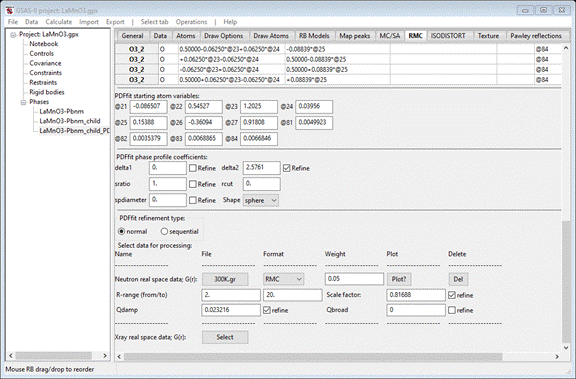PDFfit-II Atom
constraints for PDFfit from ISODISTORT
Introduction
This
is the second tutorial for PDFfit2 (“PDFfit2 and PDFgui: computer programs for
studying nanostructures in crystals." C.L. Farrow, P.Juhas, J.W. Liu, D.
Bryndin, E.S. Bozin, J. Bloch, Th. Proffen & S.J.L. Billinge, J. Phys,
Condens. Matter 19, 335219 (2007), Jour. Phys.: Cond. Matter (2007), 19,
335218. doi: https://doi.org/10.1088/0953-8984/19/33/335219)
in GSAS-II and it used to fit a neutron pair distribution function (PDF) of a
perovskite, LaMnO3, taken at 300K. As before, we will refer to
PDFfit2 as “PDFfit” in this tutorial.
In
this tutorial we will use the distortion mode analysis tool, ISODISTORT
(“ISODISTORT, ISOTROPY Software Suite.” H. T. Stokes, D. M. Hatch, and B. J.
Campbell, web site: iso.byu.edu.
"ISODISPLACE: An Internet Tool for Exploring Structural
Distortions." B. J. Campbell, H. T. Stokes, D. E. Tanner, and D. M. Hatch,
J. Appl. Cryst. (2006) 39, 607-614), calling it directly from GSAS-II to
generate the suite of atom position constraints. You must have internet access
for this tutorial.
If
you haven’t done so already, start GSAS-II.
Step 1. Setup LaMnO3
Pbnm phase
The
blank startup view of GSAS-II begins with this

First,
we need a description of the expected LaMnO3 structure (probably
generated from a powder or single crystal structure determination); this is in
the data package for this tutorial. Do Import/Phase/from
CIF file.
A file dialog box will appear. Navigate to PDFFIT-II/data and select LaMnO3 Pbnm.cif. Respond Yes to the file check box and accept the phase name as given.
The General tab will appear

The
Atoms tab shows the 4 atoms that comprise this structure

One
can create a nice drawing of this structure from the Draw Atoms tab by 1)
selecting all atoms & do Edit Figure/Fill unit cell, 2) select La atoms, do
Edit Figure/Atom style & select vdw balls, 3) select Mn atoms & do Edit
Figure/Fill CN-sphere to give

As you
look at this structure, notice that the MnO6 octahedra are twisted
about as well as tipped off the z-axis. More subtly, the La atoms are shifted
in the x,y plane as compared to what one finds for a simple cubic perovskite.
By using the ISODISTORT analysis, we can characterize these distortions more
directly by using PDFfit.
Step 2. ISODISTORT
analysis of LaMnO3
If
you access the ISODISTORT web site directly via https://iso.byu.edu/isodistort.php,
it will take you through a sequence of web pages with many possible
alternatives to choose from, but it always begins with an undistorted high
symmetry parent structure. We have reduced all this to a single preselected
step that compares a given structure (e.g. this LaMnO3 Pbnm phase)
and compares it to the undistorted parent phase and determines the possible
distortion modes and their magnitudes (ISODISTORT Method 4). This operation
results in a cif file containing all the information required by GSAS-II to
construct a mode refinement model. To begin select the ISODISTORT tab for the
Pbnm LaMnO3 phase; you should see

Of
the four analysis Methods available in ISODISTORT, we have implemented just #1
and #4. The latter is chosen as the default as it is more useful in the context
of structure analysis within GSAS-II. The first step is to select the parent
structure; it must be provided as a cif file for input to ISODISTORT. Press the
“Parent cif file” Select button; a file selection
dialog will appear. Navigate to PDFFIT-II/data and select LaMnO3 Pm3m.cif. The window will repaint to
show the choice (note that this does not import this phase into GSAS-II).

Since
we have already imported the Pbnm phase of LaMnO3 and are working
out of its ISODISTORT tab, we can use it for the “Child cif file”. Press
Use this phase? The window will repaint
giving the two choices.

We
are now all set to run ISODISTORT; you must be connected to the internet for
this to work as we are remotely accessing the https://iso.byu.edu/isodistort.php
web page and all that follows (about four more pages). Do Operations/Run ISODISTORT; the console will show a
series of messages as GSAS-II accesses various web pages at the ISODISTORT
site. It will successfully finish with a popup message

Press
OK; the console will display a
final message

indicating
that a new cif file (LaMnO3-Pbnm_child.cif) has been created. This contains all
the constraint information needed to construct them in GSAS-II. It will also be
used in the third tutorial.
Step 3. Import and
examination of ISODISTORT result
Do Import/Phase/from cif file; a file dialog box will
appear. There will be (at least) 2 files. One is the one created for input to
ISODISTORT (ISOin.cif) and the other is the result from ISODISTORT, LaMnO3-Pbnm_child.cif. Select it; respond Yes to the popup file check and leave the phase name as it is.
The console will display several messages as GSAS-II interprets the content of
the cif file and develops the appropriate constraints to make the distortion
modes as GSAS-II variables. These are then displayed in the ISODISTORT tab

Shown
are the 7 displacement modes (NB: the same number as the number of independent
atom coordinates in this Pbnm perovskite), their values in Angstroms and at the
end the atom coordinates involved in each one. To see how the various modes
change the structure, you must draw it first. (Trying the sliders now will give
you an error message). Select the Draw Atoms tab

Select
all atoms, do Edit
Figure/Fill unit cell.
Then left double click Type and select Mn; then do Edit
Figure/Fill CN-sphere.
You should see (after a bit of rotation)

Now
select the ISODISTORT tab. You can now shift the
sliders to see what each mode does to the structure. When done, press the Reset modes to save values to recover the original
structure. The tab should look like

This
would be a good time to save the project (do File/Save project).
Step 4. Setup for
PDFfit
We
now need to convert this phase (LaMnO3-Pbnm_child) into one that is setup for
PDFfit. This process creates a new phase with the constraints transformed into
PDFfit constraints. Do Operations/Make
PDFfit phase;
the window repaints with the ISODISTORT tab still selected

This
is now the third phase (LaMnO3-Pbnm_child_PDFfit); the mode information
has been transferred. Select the RMC tab and choose the PDFfit radio button; the window now displays the full suite of
atom PDFfit position constraints as developed from the ISODISTORT displacement
modes.

The
atom variables (“@21”, etc.) correspond directly with the ISODISTORT distortion
modes shown for the LaMnO3-Pbnm_child phase; their values are shown as well.
The correct target space group is given (P b n m); you should check the Refine unit cell? box. You should also choose a Uiso refinement
model. I selected Refine Uiso ?
by parent name,
that gives 4 additional parameters (“@81” – “@84”) with starting values as
listed. As with the Ni example in the 1st tutorial, change “delta2”
to 1.0 and check its Refine box. When done the RMC tab should look like
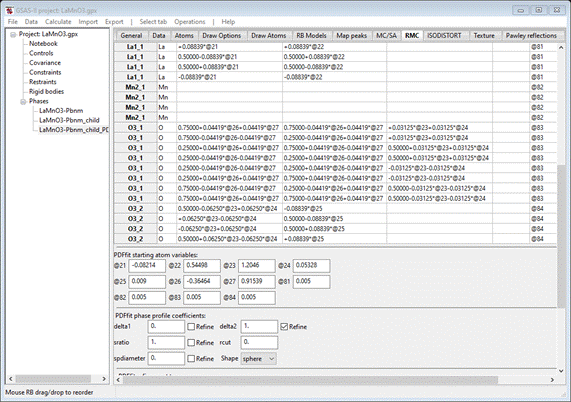
Next,
we have to add the neutron G(r) data. Press the Select button for “Neutron real space data”; a file selection
dialog will appear. Navigate to PDFFIT-II/data and select 300K.gr. Set the “from” R-range to 2.0 and check the refine boxes for Scale factor and Qdamp. When done the bottom of the window should look like
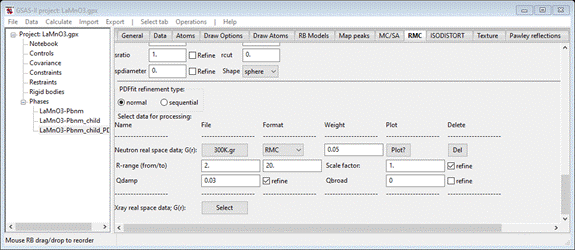
We
are now ready to run PDFfit.
Step 5. Run PDFfit
on the ISODISTORT model of LaMnO3
PDFfit executes by running in a separate process a short python
script that contains parameter setup values, refinement codes, etc. This is
prepared automatically by GSAS-II; do Operations/Setup RMC from the menu bar.
A message will appear on the console and 2 new files will appear in your
working directory. They will be named “LaMnO3-Pbnm_child_PDFfit-PDFfit”
with different extensions (.py and .stru).
To run PDFfit, do Operations/Execute from the menu bar.
You will first see a reminder to properly acknowledge your use of PDFfit (don’t
forget to cite GSAS-II as well!).
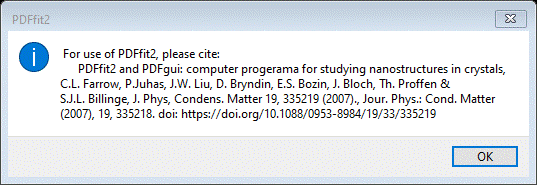
Press OK.
A new console window will appear and run quickly. A banner for PDFfit appears
followed by setup information and then its progress on refining the LaMnO3
structure. The end of the display has convergence information (Rw =
11.08%; a good fit) and a “Press any key to continue . . .” message.

Press any key, the console will vanish, and a new popup appears
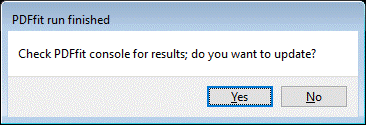
Press Yes,
The RMC window is repainted with updated values
If you do Operations/Plot from the menu, a
plot showing the fit will appear
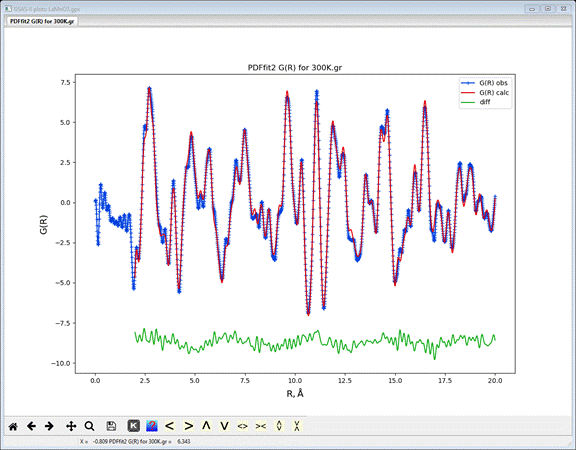
The blue curve is the original
G(r) data, the red line is the fit and the green line is the difference. Your
working directory will have 3 additional files all named “LaMnO3-Pbnm_child_PDFfit-PDFfit” with the extensions “res”, “rstr” and “fgr” (and an “N”
in the latter file name). The first is a listing of the setup information and
results from the last refinement cycle. LaMnO3-Pbnm_child_PDFfit-PDFfit.rstr is an updated version of the .stru fine and contains updated phase and atom
results with esds.
Refinement parameters:
1: 0.816877 (0.0015) 2: 0.0232163 (0.00051) 10: 2.5761 (0.042)
11: 5.54008 (0.0002) 12: 5.74347 (0.00024) 13: 7.70543 (0.00028)
21: -0.0865068 (0.0011) 22: 0.545271 (0.00084) 23: 1.20253 (0.0012)
24: 0.0395603 (0.0014) 25: 0.153875 (0.0012) 26: -0.360942 (0.0013)
27: 0.918082 (0.0014) 81: 0.00499234 (4.3e-05) 82: 0.00353793 (6.4e-05)
83: 0.00688651 (4.8e-05) 84: 0.00668457 (7.8e-05)
You can compare these (#21-27)
with the values obtained from ISODISTORT as shown here; they are basically the
same.
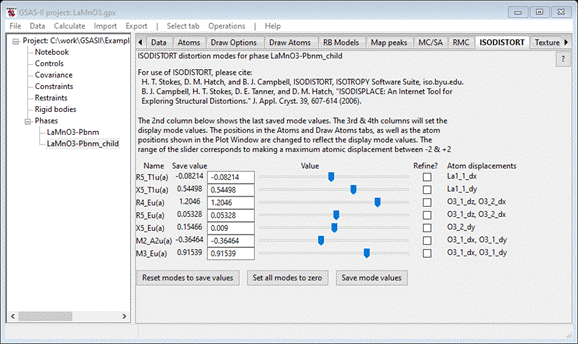
The .fgr file contains the observed and calculated PDF. Note that the lattice parameters in the General tab have been updated and the Uiso values for the atoms are shown as anisotropic in the Atoms tab. Note that the “Plot?” button does not produce this plot with obs & calc curves; it is intended only as a data inspection tool.
You should save the project as it
can be used for the next tutorial (although not required).
